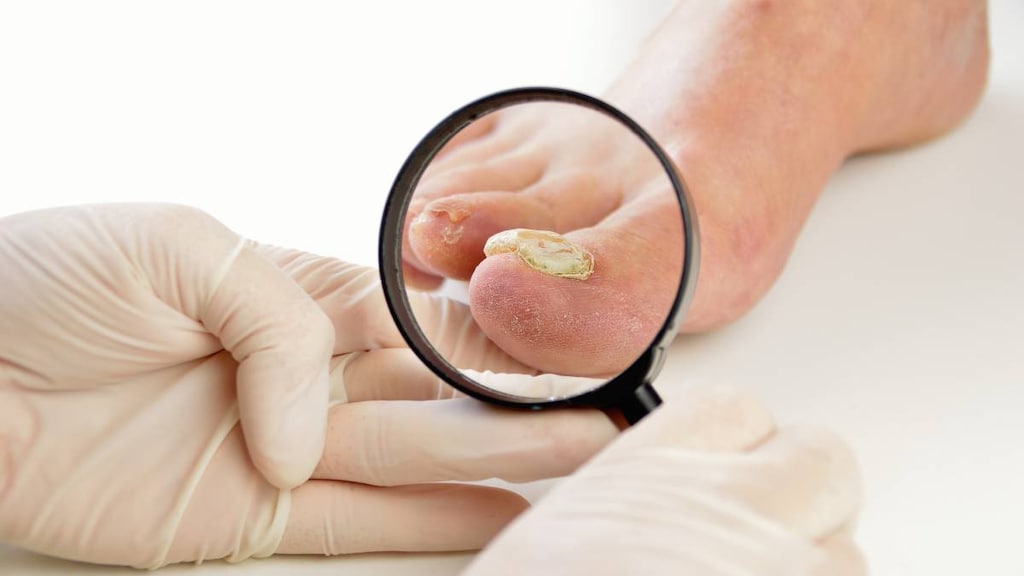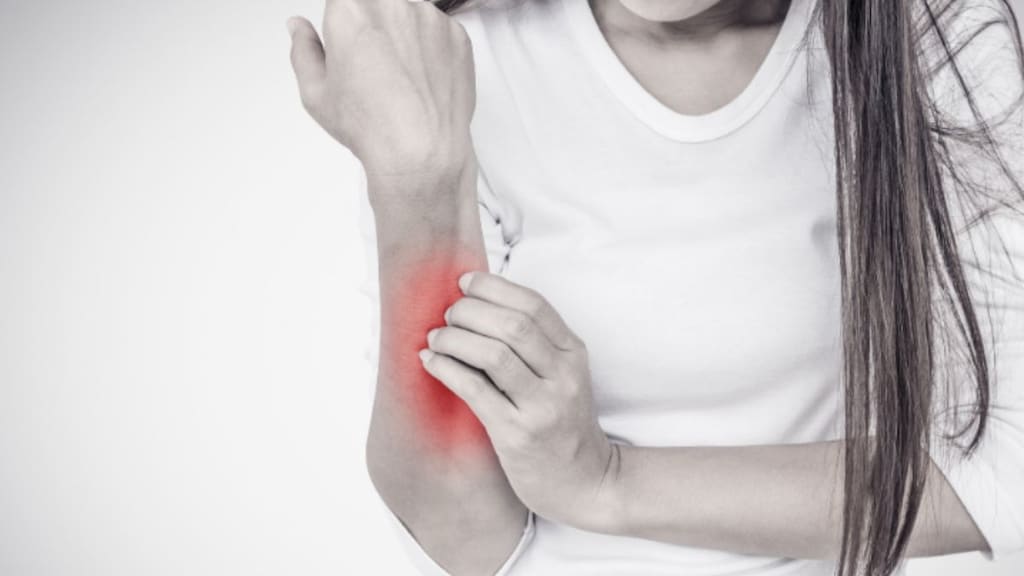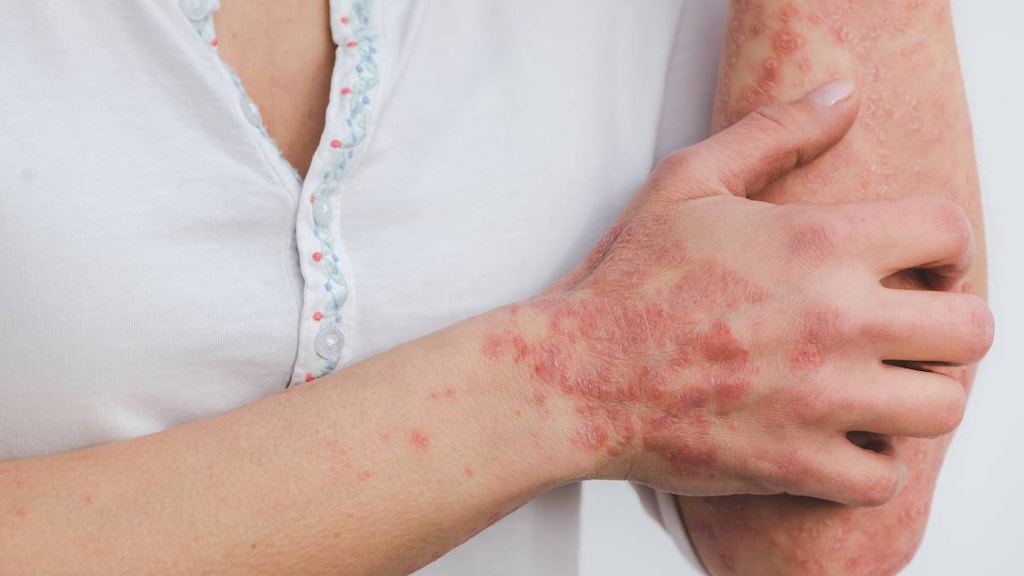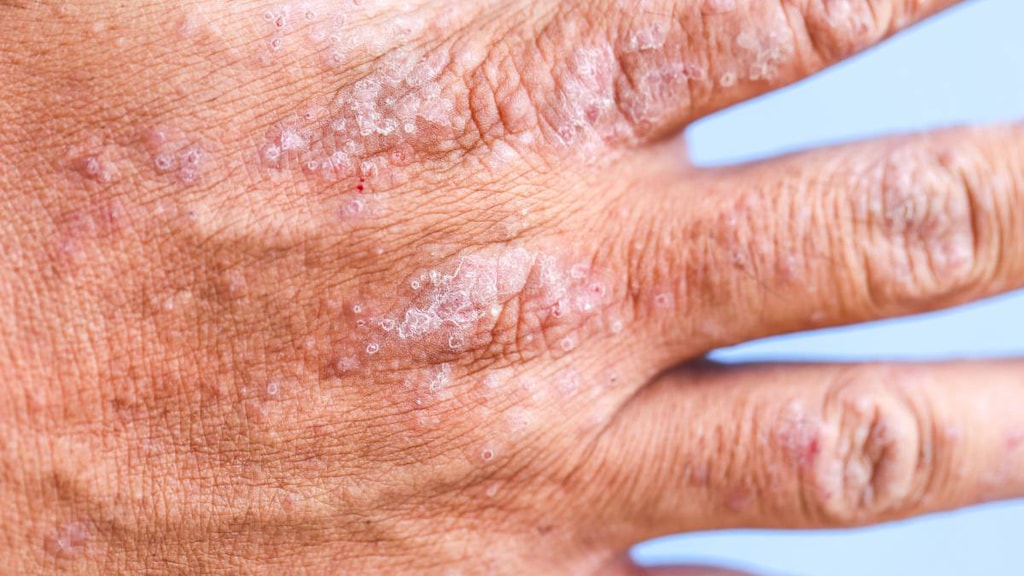Dosage Forms
Excipient information presented when available (limited, particularly for generics); consult specific product labeling. [DSC] = Discontinued product
Cream, External, as propionate:
Ultravate: 0.05% (50 g [DSC]) [contains cetyl alcohol]
Generic: 0.05% (15 g, 50 g)
Foam, External:
Halobetasol Propionate: 0.05% (50 g) [contains benzoic acid, cetostearyl alcohol, propylene glycol]
Lexette: 0.05% (50 g) [contains benzoic acid, cetostearyl alcohol, propylene glycol]
Kit, External, as propionate:
Halac: 0.05% [DSC] [contains cetyl alcohol, methylparaben, propylene glycol, propylparaben]
Lotion, External:
Bryhali: 0.01% (60 g, 100 g) [contains edetate disodium dihydrate, methylparaben, propylparaben]
Lotion, External, as propionate:
Ultravate: 0.05% (60 mL) [contains butylparaben, cetyl alcohol, propylene glycol, propylparaben]
Ointment, External, as propionate:
Ultravate: 0.05% (50 g [DSC]) [contains propylene glycol]
Generic: 0.05% (15 g, 50 g)
Pharmacology
Mechanism of Action
Topical corticosteroids have anti-inflammatory, antipruritic, and vasoconstrictive properties. May depress the formation, release, and activity of endogenous chemical mediators of inflammation (kinins, histamine, liposomal enzymes, prostaglandins) through the induction of phospholipase A2 inhibitory proteins (lipocortins) and sequential inhibition of the release of arachidonic acid. Halobetasol has high range potency.
Pharmacokinetics/Pharmacodynamics
Absorption
Percutaneous absorption is dependent on several factors, including epidermal integrity (intact vs abraded skin), formulation, and the use of occlusive dressings; <6% of a topically applied dose enters circulation within 96 hours
Metabolism
Primarily hepatic
Excretion
Urine
Use: Labeled Indications
Plaque psoriasis (foam, lotion): Treatment of plaque psoriasis in patients ≥18 years of age
Steroid-responsive dermatoses (cream and ointment): Relief of inflammatory and pruritic manifestations of corticosteroid-response dermatoses [super high potency topical corticosteroid]
Contraindications
Hypersensitivity to halobetasol or any component of the formulation
Foam, lotion: There are no contraindications listed in the manufacturer's labeling.
Canadian labeling: Additional contraindications (not in US labeling): Cream, ointment: Untreated bacterial, tubercular, and fungal skin infections; viral diseases (eg, herpes simplex, chicken pox, vaccinia)
Documentation of allergenic cross-reactivity for corticosteroids is limited. However, because of similarities in chemical structure and/or pharmacologic actions, the possibility of cross-sensitivity cannot be ruled out with certainty.
Dosage and Administration
Dosing: Adult
Plaque psoriasis: Topical:
Lotion 0.01%: Apply a thin layer to affected skin once daily for up to 8 weeks; total dosage should not exceed 50 g/week. Discontinue therapy when control is achieved; if no improvement is seen in 8 weeks, reassessment of diagnosis may be necessary.
Foam, lotion 0.05%: Apply a thin layer to affected skin twice daily for up to 2 weeks; total dosage should not exceed 50 g/week. Discontinue therapy when control is achieved; if no improvement is seen in 2 weeks, reassessment of diagnosis may be necessary.
Steroid-responsive dermatoses: Cream and Ointment: Topical: Apply sparingly to skin once or twice daily; treatment should not exceed 2 consecutive weeks and total dosage should not exceed 50 g/week. Discontinue therapy when control is achieved; if no improvement is seen in 2 weeks, reassessment of diagnosis may be necessary.
Dosing: Geriatric
Refer to adult dosing.
Dosing: Pediatric
Plaque psoriasis: Adolescents ≥18 years: Topical: Lotion: Apply a thin layer to affected skin twice daily for up to 2 weeks; total dosage should not exceed 50 g/week. Discontinue therapy when control is achieved; if no improvement is seen in 2 weeks, reassessment of diagnosis may be necessary.
Steroid-responsive dermatoses: Children ≥12 years and Adolescents: Topical: Cream, Ointment: Apply sparingly once or twice daily; maximum dose: 50 g/week; do not treat for >2 weeks. Note: To decrease risk of systemic effects, only treat small areas at any one time; discontinue therapy when control is achieved; reassess diagnosis if no improvement is seen in 2 weeks.
Administration
Topical: For external use only; not for ophthalmic, oral, or intravaginal use; do not apply to the face, scalp, groin, or axillae. Use of occlusive dressings is not recommended unless directed by a health care provider. Apply thin film to affected area and rub in gently and completely. Wash hands after application (unless treating hands).
Storage
Store at 20°C to 25°C (68°F to 77°F); excursions permitted to 15°C and 30°C (59°F to 86°F). Do not freeze.
Foam: Do not refrigerate. Do not expose container to heat and/or store at >49°C (>120°F). Contents are under pressure; do not puncture or incinerate.
Drug Interactions
Aldesleukin: Corticosteroids may diminish the antineoplastic effect of Aldesleukin. Avoid combination
Corticorelin: Corticosteroids may diminish the therapeutic effect of Corticorelin. Specifically, the plasma ACTH response to corticorelin may be blunted by recent or current corticosteroid therapy. Monitor therapy
Deferasirox: Corticosteroids may enhance the adverse/toxic effect of Deferasirox. Specifically, the risk for GI ulceration/irritation or GI bleeding may be increased. Monitor therapy
Hyaluronidase: Corticosteroids may diminish the therapeutic effect of Hyaluronidase. Management: Patients receiving corticosteroids (particularly at larger doses) may not experience the desired clinical response to standard doses of hyaluronidase. Larger doses of hyaluronidase may be required. Consider therapy modification
Ritodrine: Corticosteroids may enhance the adverse/toxic effect of Ritodrine. Monitor therapy
Adverse Reactions
>10%: Endocrine & metabolic: HPA-axis suppression (6% to 16%)
1% to 10%:
Central nervous system: Headache (1%)
Dermatologic: Stinging of the skin (≤4%), telangiectasia (≤1%)
Endocrine & metabolic: Hyperglycemia (1%)
Local: Application site burning (≤4%), application-site pruritus (≤4%), application site atrophy (1%), application-site dermatitis (1%), application site pain (1%)
Respiratory: Upper respiratory tract infection (2%)
Frequency not defined:
Central nervous system: Paresthesia
Dermatologic: Acne vulgaris, leukoderma, local dryness of skin, miliaria, pustules, secondary skin infection, urticaria
Local: Application site erythema, application site rash, application site vesicles
<1%, postmarketing, and/or case reports: Herpes zoster infection, increased blood pressure, influenza, local skin discoloration, nasopharyngitis, otitis media, pharyngitis, skin atrophy, wound
Warnings/Precautions
Concerns related to adverse effects:
- Adrenal suppression: May cause hypercortisolism or suppression of hypothalamic-pituitary-adrenal (HPA) axis, particularly in younger children or in patients receiving high doses for prolonged periods. HPA axis suppression may lead to adrenal crisis.
- Contact dermatitis: Allergic contact dermatitis can occur and is usually diagnosed by failure to heal rather than clinical exacerbation. Discontinue therapy if contact dermatitis develops.
- Kaposi sarcoma: Prolonged treatment with corticosteroids has been associated with the development of Kaposi sarcoma (case reports); if noted, discontinuation of therapy should be considered (Goedert 2002).
- Local effects: Local adverse reactions may occur (eg, skin atrophy, striae, telangiectasias, burning, itching, irritation, dryness, folliculitis, acneiform eruptions, hypopigmentation, perioral dermatitis, allergic contact dermatitis, secondary infection miliaria); may be irreversible. Local adverse reactions are more likely to occur with use of higher potency corticosteroids, occlusive dressings, and/or prolonged use. If local adverse reactions develop, discontinue use and institute appropriate therapy until skin integrity is restored.
- Ocular effects: Topical corticosteroids may increase the risk of posterior subcapsular cataracts and glaucoma. Monitor for ocular symptoms. Avoid contact with eyes.
- Skin infections: Use appropriate antibacterial or antifungal agents to treat concomitant skin infections; discontinue treatment if infection does not resolve promptly.
- Systemic effects: Topical corticosteroids may be absorbed percutaneously. Absorption of topical corticosteroids may cause manifestations of Cushing's syndrome, hyperglycemia, or glycosuria. Absorption is increased by the use of occlusive dressings, application to denuded skin, or application to large surface areas.
Special populations:
- Pediatric: Children may absorb proportionally larger amounts after topical application and may be more prone to systemic effects. HPA axis suppression, intracranial hypertension, and Cushing's syndrome have been reported in children receiving topical corticosteroids. Prolonged use may affect growth velocity; growth should be routinely monitored in pediatric patients.
Dosage form specific issues:
Foam: Topical foam is flammable; avoid fire, flame, or smoking during and immediately following application.
Other warnings/precautions:
- Appropriate use: If no improvement is seen within anticipated timeframe, reassessment of diagnosis may be necessary. Do not use the cream or ointment for the treatment of perioral dermatitis or rosacea.
Monitoring Parameters
Growth in pediatric patients; signs/symptoms of HPA axis suppression/adrenal insufficiency; bacterial or fungal skin infection
Pregnancy
Pregnancy Considerations
Systemic bioavailability of topical corticosteroids is variable (eg, integrity of skin, use of occlusion) and may be further influenced by trimester of pregnancy (Chi 2017). In general, the use of topical corticosteroids is not associated with a significant risk of adverse pregnancy outcomes. However, there may be an increased risk of low-birth-weight infants following maternal use of potent or very potent topical products, especially in high doses. Use of mild to moderate potency topical corticosteroids is preferred in pregnant females and the use of large amounts or use for prolonged periods of time should be avoided (Chi 2016; Chi 2017; Murase 2014). Also avoid areas of high percutaneous absorption (Chi 2017). The risk of stretch marks may be increased with use of topical corticosteroids (Murase 2014).
The treatment of psoriasis in pregnancy is initiated with conservative treatment as in nonpregnant females. When a topical steroid is needed, low to moderate potency corticosteroids are preferred initially. High-potency topical steroids should be used only when clearly needed and after the first trimester (Bae 2012).
Patient Education
- Discuss specific use of drug and side effects with patient as it relates to treatment. (HCAHPS: During this hospital stay, were you given any medicine that you had not taken before? Before giving you any new medicine, how often did hospital staff tell you what the medicine was for? How often did hospital staff describe possible side effects in a way you could understand?)
- Patient may experience dry skin, burning, itching, or stinging. Have patient report immediately to prescriber signs of high blood sugar (confusion, fatigue, increased thirst, increased hunger, passing a lot of urine, flushing, fast breathing, or breath that smells like fruit), signs of Cushings disease (weight gain in upper back or abdomen; moon face; severe headache; or slow healing), signs of adrenal gland problems (severe nausea, vomiting, severe dizziness, passing out, muscle weakness, severe fatigue, mood changes, lack of appetite, or weight loss), signs of skin changes (acne, stretch marks, slow healing, or hair growth), skin thinning, vision changes, or severe skin irritation (HCAHPS).
- Educate patient about signs of a significant reaction (eg, wheezing; chest tightness; fever; itching; bad cough; blue skin color; seizures; or swelling of face, lips, tongue, or throat). Note: This is not a comprehensive list of all side effects. Patient should consult prescriber for additional questions.
Intended Use and Disclaimer: Should not be printed and given to patients. This information is intended to serve as a concise initial reference for health care professionals to use when discussing medications with a patient. You must ultimately rely on your own discretion, experience, and judgment in diagnosing, treating, and advising patients.



